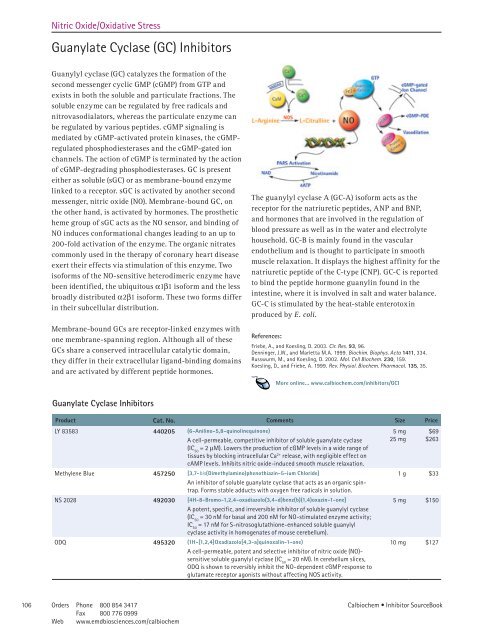Inhibitor SourceBook™ Second Edition
Inhibitor SourceBook™ Second Edition
Inhibitor SourceBook™ Second Edition
You also want an ePaper? Increase the reach of your titles
YUMPU automatically turns print PDFs into web optimized ePapers that Google loves.
Nitric Oxide/Oxidative Stress<br />
Guanylate Cyclase (GC) <strong>Inhibitor</strong>s<br />
Guanylyl cyclase (GC) catalyzes the formation of the<br />
second messenger cyclic GMP (cGMP) from GTP and<br />
exists in both the soluble and particulate fractions. The<br />
soluble enzyme can be regulated by free radicals and<br />
nitrovasodialators, whereas the particulate enzyme can<br />
be regulated by various peptides. cGMP signaling is<br />
mediated by cGMP-activated protein kinases, the cGMPregulated<br />
phosphodiesterases and the cGMP-gated ion<br />
channels. The action of cGMP is terminated by the action<br />
of cGMP-degrading phosphodiesterases. GC is present<br />
either as soluble (sGC) or as membrane-bound enzyme<br />
linked to a receptor. sGC is activated by another second<br />
messenger, nitric oxide (NO). Membrane-bound GC, on<br />
the other hand, is activated by hormones. The prosthetic<br />
heme group of sGC acts as the NO sensor, and binding of<br />
NO induces conformational changes leading to an up to<br />
200-fold activation of the enzyme. The organic nitrates<br />
commonly used in the therapy of coronary heart disease<br />
exert their effects via stimulation of this enzyme. Two<br />
isoforms of the NO-sensitive heterodimeric enzyme have<br />
been identified, the ubiquitous a1b1 isoform and the less<br />
broadly distributed a2b1 isoform. These two forms differ<br />
in their subcellular distribution.<br />
Membrane-bound GCs are receptor-linked enzymes with<br />
one membrane-spanning region. Although all of these<br />
GCs share a conserved intracellular catalytic domain,<br />
they differ in their extracellular ligand-binding domains<br />
and are activated by different peptide hormones.<br />
Guanylate Cyclase <strong>Inhibitor</strong>s<br />
The guanylyl cyclase A (GC-A) isoform acts as the<br />
receptor for the natriuretic peptides, ANP and BNP,<br />
and hormones that are involved in the regulation of<br />
blood pressure as well as in the water and electrolyte<br />
household. GC-B is mainly found in the vascular<br />
endothelium and is thought to participate in smooth<br />
muscle relaxation. It displays the highest affinity for the<br />
natriuretic peptide of the C-type (CNP). GC-C is reported<br />
to bind the peptide hormone guanylin found in the<br />
intestine, where it is involved in salt and water balance.<br />
GC-C is stimulated by the heat-stable enterotoxin<br />
produced by E. coli.<br />
References:<br />
Friebe, A., and Koesling, D. 2003. Cir. Res. 93, 96.<br />
Denninger, J.W., and Marletta M.A. 999. Biochim. Biophys. Acta 1411, 334.<br />
Russwurm, M., and Koesling, D. 2002. Mol. Cell Biochem. 230, 59.<br />
Koesling, D., and Friebe, A. 999. Rev. Physiol. Biochem. Pharmacol. 135, 35.<br />
More online... www.calbiochem.com/inhibitors/GCI<br />
Product Cat. No. Comments Size Price<br />
LY 83583 440205 (6-Anilino-5,8-quinolinequinone)<br />
A cell-permeable, competitive inhibitor of soluble guanylate cyclase<br />
(IC 50 = 2 mM). Lowers the production of cGMP levels in a wide range of<br />
tissues by blocking intracellular Ca 2+ release, with negligible effect on<br />
cAMP levels. Inhibits nitric oxide-induced smooth muscle relaxation.<br />
Methylene Blue 457250 [3,7-bis(Dimethylamino)phenothiazin-5-ium Chloride]<br />
An inhibitor of soluble guanylate cyclase that acts as an organic spintrap.<br />
Forms stable adducts with oxygen free radicals in solution.<br />
NS 2028 492030 [4H-8-Bromo-1,2,4-oxadiazolo(3,4-d)benz(b)(1,4)oxazin-1-one]<br />
A potent, specific, and irreversible inhibitor of soluble guanylyl cyclase<br />
(IC 50 = 30 nM for basal and 200 nM for NO-stimulated enzyme activity;<br />
IC 50 = 7 nM for S-nitrosoglutathione-enhanced soluble guanylyl<br />
cyclase activity in homogenates of mouse cerebellum).<br />
ODQ 495320 (1H-[1,2,4]Oxadiazolo[4,3-a]quinoxalin-1-one)<br />
A cell-permeable, potent and selective inhibitor of nitric oxide (NO)sensitive<br />
soluble guanylyl cyclase (IC 50 = 20 nM). In cerebellum slices,<br />
ODQ is shown to reversibly inhibit the NO-dependent cGMP response to<br />
glutamate receptor agonists without affecting NOS activity.<br />
06 Orders Phone 800 854 34 7<br />
Calbiochem • <strong>Inhibitor</strong> SourceBook<br />
Fax 800 776 0999<br />
Web www.emdbiosciences.com/calbiochem<br />
5 mg<br />
25 mg<br />
$69<br />
$263<br />
g $33<br />
5 mg $ 50<br />
0 mg $ 27



